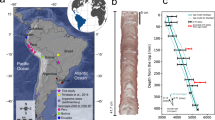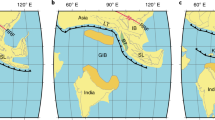Abstract
SARDINIA is situated about halfway between France and Italy in the Mediterranean. Geologists1–3 have suggested that Sardinia has not always been in this position, but was once much nearer to France. From that original position, it is suggested that the island drifted to its present location either before2 or after1 the Middle Tertiary. The palaeomagnetic method is suited, given fulfilment of several conditions, to test such a hypothesis because drifting of Sardinia in the manner geologists have suggested could not have occurred without an anticlockwise rotation of the island. Rotation should be detectable by comparing palaeomagnetic directions from Sardinia with directions from continental Europe. In this communication, palaeomagnetic data of sixty hand samples from Middle Tertiary volcanic rocks near Alghero are used for comparison.
This is a preview of subscription content, access via your institution
Access options
Subscribe to this journal
Receive 51 print issues and online access
$199.00 per year
only $3.90 per issue
Buy this article
- Purchase on Springer Link
- Instant access to full article PDF
Prices may be subject to local taxes which are calculated during checkout
Similar content being viewed by others
References
Argand, E., Int. Geol. Congr., 173 (1922).
Dubordieu, G., CR. Acad. Sci., 254, 510 (1962).
Carey, S. W., A Tectonic Approach to Continental Drift, 251 (University of Tasmania, Hobart, 1958).
Deriu, M., Mem. Soc. Geol. Ital., 3, 675 (1962).
Sanna, G., thesis, Geol. Inst. Univ. Bologna (1965).
Moretti, A., Deriu, M., Jacobacci, A., Malatesta, A., Perno, U., and Segre, A. G., 1 : 100,000 Geol. Maps 192 and 193 of Italy (1959).
As, J. A., in Methods in Palaeomagnetism (edit. by Collinson, D. W., Creer, K. M., and Runcorn, S. K.), 254 (Elsevier, Amsterdam, 1966).
Zijdervold, J. D. A., in Methods in Palaeomagnetism (edit. by Collinson, D. W., Creer, K. M., and Runcorn, S. K.), 254 (Elsevier, Amsterdam, 1966).
Roche, A., CR. Acad. Sci., 377 (1960).
Lauer, J. P., Ber. Naturf. Ges. Freiburg i. Br., 54, 279 (1964).
Nairn, A. E. M., Notizbl. Hess. Landesamt Bodenforsch. Wiesbaden, 90, 412 (1962).
Nairn, A. E. M., Geofys. Sbor., 252 (1966).
Nairn, A. E. M., and Kürsten, M., Neus. Jb. Geol. Päleont., Mh., 8, 348 (1959).
Roche, A., CR Acad. Sci., 230, 113 (1950).
Roche, A., CR Acad. Sci., 230, 1603 (1950).
Roche, A., CR Acad. Sci., 233, 1132 (1951).
Roche, A., CR Acad. Sci., 236, 107 (1953).
Roche, A., Rev. Sci. Nat. d'Auvergne, N. sér., 25, 147 (1959).
Roche, A., and Lauer, J. P., CR Acad. Sci., 258, 1580 (1964).
Author information
Authors and Affiliations
Rights and permissions
About this article
Cite this article
DE JONG, K., MANZONI, M. & ZIJDERVELD, J. Palaeomagnetism of the Alghero Trachyandesites. Nature 224, 67–69 (1969). https://doi.org/10.1038/224067a0
Received:
Issue Date:
DOI: https://doi.org/10.1038/224067a0
This article is cited by
-
The palaeorotation of the troodos microplate, cyprus, in the late mesozoic-early cenozoic plate tectonic framework of the Eastern Mediterranean
Surveys in Geophysics (1986)
-
Palaeomagnetism of Plio-Pleistocene Basalts from North-west Sardinia
Nature Physical Science (1973)
-
Palaeomagnetic Evidence for Rotation of Sardinia during the Early Miocene
Nature (1973)
-
Further Data on the Corsica–Sardinia Rotation
Nature (1973)
-
Rotation of the Corsica–Sardinia Microplate
Nature Physical Science (1972)
Comments
By submitting a comment you agree to abide by our Terms and Community Guidelines. If you find something abusive or that does not comply with our terms or guidelines please flag it as inappropriate.



